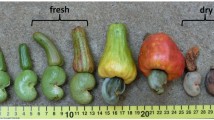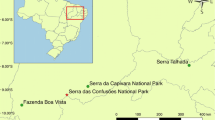Abstract
While some reports that capuchins crack nuts or hard-shelled fruit to eat have already been presented, it has been unknown whether such behavior is only one of the varied feeding habits of capuchins or if it is also a behavior adaptive to their habitats, a behavior which requires the use of hands and mastering of skill related to tool-using behavior. On a border of La Macarena National Park in Colombia, the authors minutely observed the feeding behavior of the black-capped capuchin, in which the monkey skillfully fed on the albumen of the fruit of cumare, a kind of cocoid palm-fruit, using two different methods, according to the degree of ripeness of the fruit. The characteristic behavior developed by the black-capped capuchin while eating the fruit of cumare could be fixed as one of the higher level adaptive behaviors of the animal to his habitat.
Similar content being viewed by others
References
Goodall, J., 1965. Chimpanzees of the Gombe Stream Reserve. In:Primate Behavior,I. DeVore (ed.), Holt, Rinehart, & Winston, Inc., pp. 425–473.
Hill, W. C. O., 1960.Primates. Comparative Anatomy and Taxonomy. IV. Cebidae, Part A. Edinburgh Univ. Press.
Izawa, K., 1973. Societies of New World monkeys.Shizen 28(6): 48–55. (in Japanese)
————, 1975. Foods and feeding behavior of monkeys in the Upper Amazon Basin.Primates, 16: 295–316.
————, 1976. Group sizes and composition of monkeys in the Upper Amazon Basin.Primates, 17: 367–399.
————, 1966. Chimpanzees in Kasakati Basin, Tanganyika. (1) Ecological study in the rainy season 1963–1964.Kyoto Univ. African Studies, 1: 73–156.
Kawai, M., 1965. Newly-acquired pre-cultural behavior of the natural troop of Japanese monkeys on Koshima Island.Primates, 6: 1–30.
Klein, L. L. & D. J. Klein, 1973. Social and ecological contrasts between four taxa of neotropical primates (Ateles belzebuth, Alouatta seniculus, Saimiri sciureus, andCebus apella). Presented at 9th Int. Cong. Anthrop. Ethnol. Sci., Sept. 1973, Chicago.
Moynihan, M., 1976.The New World Primates. Princeton Univ. Press, Princeton.
Nishimura, A. & K. Izawa, 1975. The group characteristics of woolly monkeys (Lagothrix lagothricha) in the Upper Amazonian Basin. In:Contemporary Primatology. 5th Int. Cong. Primat., Nagoya, 1974,S. Kondo, M. Kawai, & A. Ehara (eds.), S. Karger, pp. 351–357.
Oppenheimer, J., 1968. Behavior and ecology of the white faced monkey,Cebus capuchinus, on Barro Colorado Island. Univ. Microfilms Ltd.
van Lawick-Goodall, J., 1971.In the Shadow of Man. William Collins Sons & Co., Ltd.
Author information
Authors and Affiliations
About this article
Cite this article
Izawa, K., Mizuno, A. Palm-fruit cracking behavior of wild black-capped capuchin (Cebus apella). Primates 18, 773–792 (1977). https://doi.org/10.1007/BF02382930
Received:
Accepted:
Issue Date:
DOI: https://doi.org/10.1007/BF02382930




